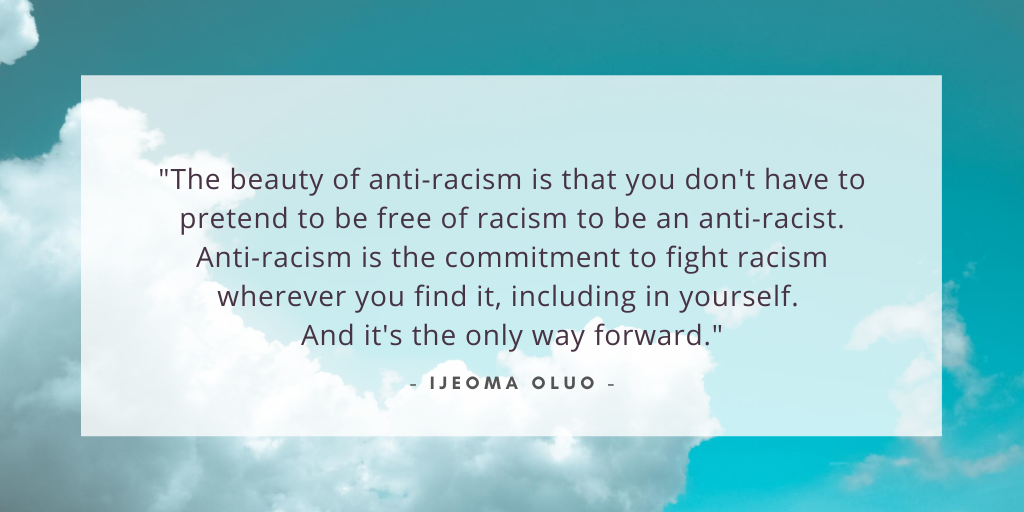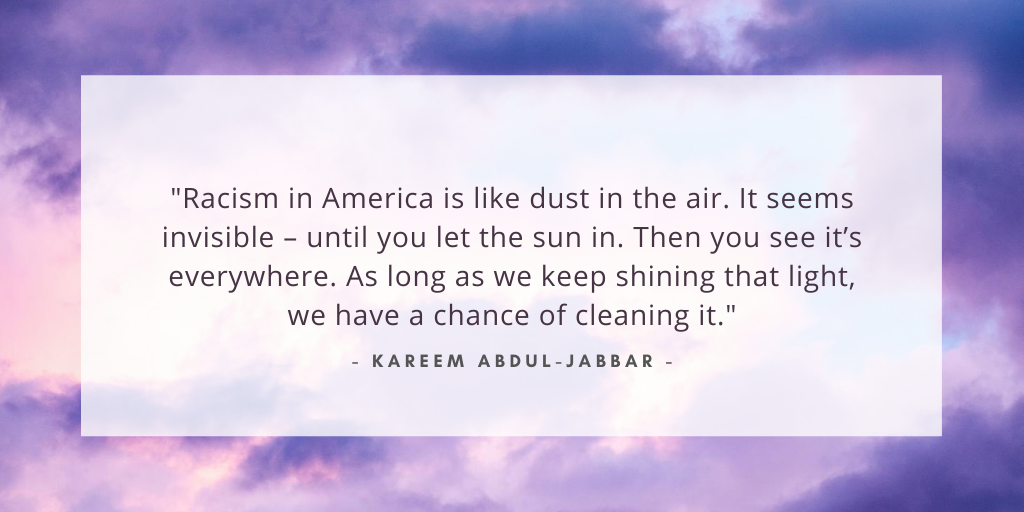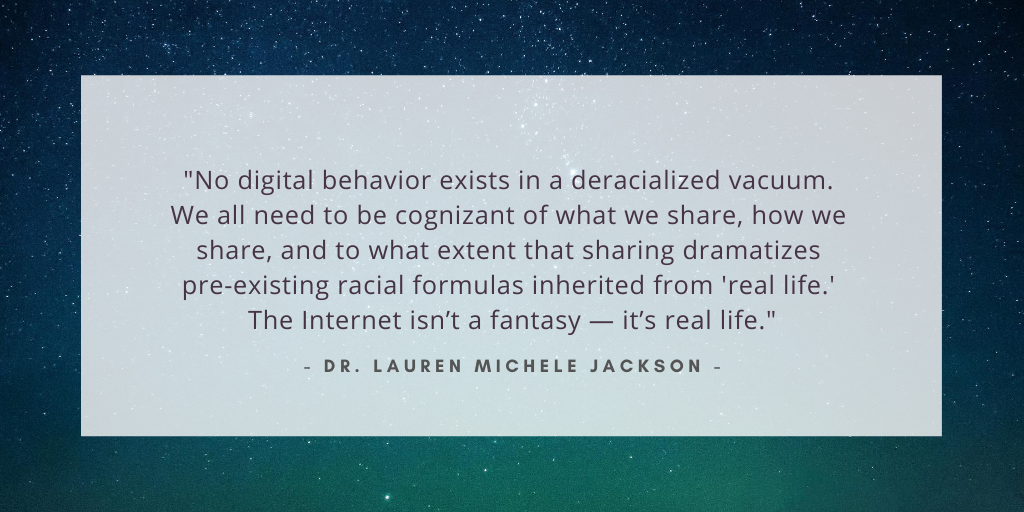I previously wrote about how to be unwaveringly anti-racist as a student affairs professional.
…And it’s extremely important that we continue prioritizing being anti-racist in virtual settings.
As a reminder, being anti-racist entails rejecting the neutrality of merely being “not racist.” Being anti-racist means actively identifying and describing racism, evaluating the impact of our actions to make sure they are not harmful or creating biases, and taking proactive steps to dismantle racism.
Now, here are some ways to make sure that you are being anti-racist in your virtual programming.

1. Establish ground rules before your programs begin
First, if you want to have programming guided by anti-racist principles, it’s important to establish some ground rules for what is acceptable in the virtual setting and how you will address behaviors that are unacceptable.
These rules can be shared verbally during the presentation or in writing via a slide or graphic that you show at the beginning of your event. If you are concerned about time, you can create a mandatory program or training that students must complete prior to participating in any virtual programming, or you can create a recording that folx will listen to prior to participating in virtual programs.
Virtual backgrounds should be part of your ground rules discussion. Make it clear that you strive for an inclusive and equitable virtual space, so offensive, disrespectful, or harmful virtual backgrounds will not be tolerated. To determine what is offensive or harmful, you can reference your institution’s code of conduct. You can also indicate that anything leading to a hostile environment, such as racist words or symbols, will not be tolerated.
You should also define what a productive discussion looks like. Encourage active listening, sharing of ideas and perspectives, and open-mindedness. At the same time, let people know that they should be open to critique and feedback of their ideas and thoughts.
Discussing race can be difficult, so it’s important to let your coworkers and students know that we can validate someone’s experience and affirm their feelings while still discussing and analyzing ideas. However, it’s important that we establish that the humanity of people is not up for debate, and that racism, sexism, homophobia, or other forms of discrimination and biases will not be tolerated.
You should also discuss and define problematic behaviors such as microaggressions. Additionally, let people know what type of corrective action you’ll take towards addressing these problematic behaviors. That includes calling people out and calling people in.
One way of understanding the difference between calling in and calling out is that you call out the behavior and call in the person. Let people know that you will have to call out bad and harmful behavior so that all participants will know what won’t be tolerated. At the same time, you can call people in to get them to reflect on their behavior and explore the reasons for their actions as well as the ramification of those actions. You will find some great examples here.
2. Discuss why it’s important to talk about race
Along with your ground rules, you should also explain why it’s important to have open, honest discussions about race and its prevalence within every facet of society.

I’ve previously written about anti-racist statements, and you can follow a similar template here. If you wish to discuss race and anti-racism in a program, you should do the following at the start of it:
- Acknowledge that racism plays a role in nearly every aspect of society, that racism exists unconsciously and consciously, and that everyone needs to take ownership of identifying and addressing racism.
- Challenge your program participants to think about race and racial inequities, along with ways to address and disrupt racism.
- Establish that the plan is to turn conversations about racism and inequality into actions and systems of accountability.
Whether you are meeting in-person or virtually, you have to establish spaces wherein you are intentionally discussing race. Additionally, it’s important to not treat Whiteness as the “norm.”
3. Explain digital blackface and cultural appropriation
In a virtual atmosphere, it is common to use GIFs and memes. But it’s important to explain to your non-Black participants that while using many GIFs and memes featuring Black people might seem harmless, it can actually be extremely damaging.
The usage of GIFs and memes of Black people by non-Black people can be what experts call “digital blackface.” Writer and psychologist-in-training Jardin Dogan describes digital blackface as when “non-Black people use the images and voices of Black individuals to explain emotions or phenomena.” Dogan says “it’s when people use images to claim Black identity, but they don’t identify as Black.”
Psychologist Riana Elyse Anderson explains that “when you’re talking about GIFs, these are typically things that are more jovial in nature. But, because of the historical roots of minstrelsy and entertainment value, to non-Black people they represent an exaggeration, rather than someone who can be an expert on something, or a leader, anything deemed ‘serious.’”
If you look on Twitter, you will quickly find GIFs like these, which depict Black people in stereotypic ways. Some examples can be found here, here, and here.
Dogan explains that digital blackface is a form of cultural appropriation, wherein people can take on and take off Blackness when it is convenient. She also states that as a result of continually viewing such GIFs and memes, non-Black people might develop new implicit biases about Black people and apply them to everyday life.
Dogan urges people to consider, for instance, that a non-Black person can use a GIF or meme of a “sassy Black woman” without consequences, but a Black woman could lose her job or be negatively described or label as “sassy.”
If we are aiming to practice anti-racism in our work and with our students, this is a simple step we can take. It will help avoid perpetuating stereotypes and biases that harm Black folx.
To be clear, I am not suggesting that non-Black folx never use a picture with a Black person in it. But, it’s important that non-Black folx be cognizant of what pictures they’re using, why they’re using them, and the implications of using those pictures.

By actively encouraging non-Black folks to not use GIFs and memes of Black folx to explain emotions and phenomena (especially when they reinforce stereotypes), we are helping to ensure that our virtual spaces are more inclusive.
4. Discuss the use of AAVE/BVE and avoiding “verbal blackface”
It is important to make sure that non-Black people understand the effects and impact of using African American Vernacular English, AKA Black Vernacular English.
Words like “bae”, “on fleek”, “rachet”, “lit”, “woke” and more have made their way into common American vernacular across all races. Phrases like “yas queen” and “spilling the tea,” which can be traced back to Black LGBTQ+ folx in the ballroom scene, are also increasingly popular.
The usage of certain words and phrases by non-Black people can be highly problematic. Much like using GIFs and memes, the usage of AAVE/BVE could represent attempts from non-White folx to look cool or receive certain cultural benefits. Yet, such speakers and writers still get to maintain privileges that Black folx do not have. This is called “verbal blackface.”
Linguistics Kyle Freeman and writer Luna Malbroux provide some helpful guidelines for non-Black people in using AAVE/BVE. Both emphasize that you should not use AAVE/BVE for financial gain, personal gain, or performative or tokenizing reasons. Instead, prior to using AAVE/BVE, one should look closely at the relationship they and their culture have to those words and the people who use those words.
Freeman says you should ask yourself:
- Do you have significant personal relationships to the people who are using these words?
- Are you anti-Black in your attitudes and behaviors?
Malbroux expands upon that and says you should ask yourself four things prior to using AAVE/BVE slang:
- Are you commercializing it for your financial gain?
- Is it performative or tokenizing?
- Are you using it to ‘level up’ or earn ‘street’ credentials?
- Are you in proximity (or feel a distinct closeness) to the originating culture?
When we’re thinking about being anti-racist in the virtual world, we must continually evaluate the intent and impact of language.

The virtual world is a reality for many of our institutions, and although programming might look different for many of us right now, we must prioritize anti-racism — regardless of the format. Virtually, it is imperative to create spaces that clearly show our commitment to discussing race and racism, take action to address racism, and hold each other accountable for being anti-racist.





